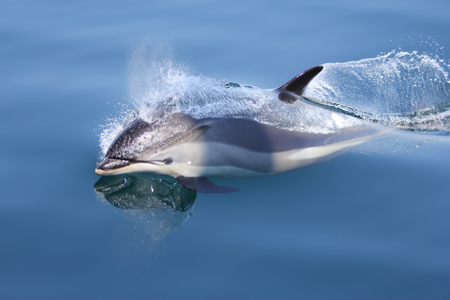After two weeks at sea we put in to St George’s harbour Bermuda. This was an unscheduled stop but with time in hand it was a good opportunity to get a seam on the main sail which had opened up a week before repaired. We spent five days in moored in St George’s while the sail was repaired and preparing for the final leg of our journey to Boston. Our stay coincided with the most persistent rain the islands have seen in years and a rather wet “Bermuda Day” where the nation’s heritage is celebrated with a carnival held in the capital, Hamilton.
On the 25th May, we set sail for Boston accompanied by sooty and great shearwaters, great and pomarine skuas, majestic white-tailed tropic birds and flying fish. Before we’d even finished deploying the hydrophones, we were joined by an acrobatic bottlenose dolphin with two remoras attached to its stomach.
The next few days were a mixture of flat calm seas with no wind, perfect for A-frame observations, and windy days with rough seas, great sailing weather but not so good for sightings. Fortunately, with the hydrophones deployed, we were able to continue surveying and collecting acoustic data even when conditions were challenging.
As we ventured north, we found ourselves fighting against the Gulf Stream, which slowed us down by as much as 5 knots. Its effects were also apparent in the sea surface temperature, which dropped from 22 degrees in the ocean current, to 13 degrees as we neared the coast of North America.
We were joined many times along the way by exuberant Atlantic spotted dolphins and had a wonderful encounter with a sperm whale logging at the surface on an incredibly calm day. As we watched the whale resting, three groups of pilot whales surfaced all around us, one group right next to the sperm whale. Listening to the hydrophones, we were able to hear the sperm whale’s loud, regular clicks along with the haunting whistles of the pilot whales.
On the penultimate day of our Atlantic voyage, as we neared George’s Bank, off Cape Cod, at dawn, shrouded in thick fog, the sea took on an eerie calm. Our first encounter was with a fin whale, which surfaced 20m from the boat – any further away and we’d have missed it in the fog! We were then joined by Atlantic white-sided dolphins, a species we hadn’t yet encountered on this survey. They are one of the larger oceanic dolphins, just under three metres in length, and put on a spectacular display as they swam through the mirror-calm water. Shortly afterwards we had our first sighting of a humpback whale, lifting its tail flukes out of the water, before diving down and out of sight.

We also recorded numerous basking sharks, the second largest fish in the world, filter feeding on plankton just below the surface, alongside hundreds of storm petrels, the smallest of all seabirds, feeding from above. As we were watching the storm petrels dancing on the ocean, out of nowhere a minke whale surfaced alongside us, 30m from the boat, another first for this survey.

The following morning we arrived in Boston, Massachusetts, the final stop for myself, Kerry and Michelle. We will be here for a few weeks before heading home, while the boat is open to the public to raise awareness about marine conservation. The rest of the team will then begin research in the Stellwagen Bank Marine Sanctuary before heading to Iceland in July.
Sorry, comments are closed for this post.